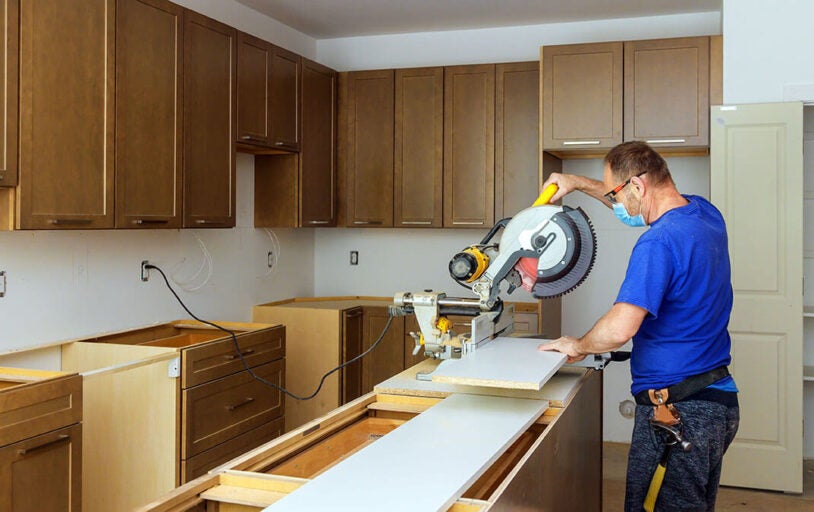
How To Fund Home Improvement Projects
9/10/2024

Home improvement projects can become costly very quickly, and figuring out how to pay for them can be overwhelming. Homeowners sometimes find that they have to postpone their renovations due to supply shortages or high costs.
There are various ways homeowners can finance and fund home improvement projects. Before starting a project, it’s important to consider your options and choose what’s best for your financial situation.
Save
You can save up to fund your home improvement project by setting aside money every month. Planning to save for your home improvement project can mean you’ll have to wait to start your project, but you won’t have to worry about paying back a loan or a large credit card bill once you finish your renovation project.
The amount you need to save will depend on the type of home renovation project you’re planning and the scope of your project. For example, if you’re planning on renovating your entire kitchen, you’ll likely need to save more than if you’re planning a smaller home improvement project like painting your house or upgrading a few appliances in your home.
When saving up for home improvement projects, you can work on projects over time. Start with smaller projects or aspects of your project that you’ve already saved for.
Pros of Saving
There are a lot of benefits to saving for a home renovation project. Using savings means you won’t have any debt to pay back after the project is complete, no accruing interest, and your credit score won’t be impacted.
Cons of Saving
One of the major concerns when saving for a home renovation project is the time it can take to save for a project and how that may delay your renovation. With costs going up, waiting to start a project could mean your project will cost more than expected.
For some projects, saving up to fund the home improvement may not be an option. If your project is an emergency, you likely won’t have the time to save money to pay for it.
Home Improvement Loan
A home improvement loan is often an unsecured personal loan offered by financial institutions for home renovations. This prevents your home from being used as collateral.
The interest rate and loan qualification are based on a number of factors, including your credit score, debt-to-income ratio, and the current market. Once you qualify for a home improvement loan, you get access to the funds quickly.
Home improvement loans usually have a shorter repayment timeline than other loan options. These loans are also available in lower loan amounts, which makes them great for smaller projects.
Because home improvement loans can be unsecured, they tend to have higher interest rates than secured loan options.
Pros
A home improvement loan is a great option for home renovation projects. You can access the funds quickly, with few fees, and you don’t risk losing your home if you can’t repay your loan.
Cons
You should consider a few things when looking for home improvement loans. When compared to other home renovation borrowing options, home improvement loans have lower maximum borrowing amounts, which could limit the size of the project you can complete.
Home improvement loans tend to have shorter repayment periods, which could mean that your payments are higher than they would be with other loan options and that you may have a higher interest rate than other borrowing options.
Home Equity Line of Credit
A home equity line of credit (HELOC) is a secured loan that uses the equity in your home as collateral to open a revolving credit line. With a HELOC, you can borrow the amount of money you need as you need it, up to your borrowing limit.
HELOCs are a great option for longer, bigger projects because they allow you to access funds for longer and take more out as you need it.
Getting a loan where your house is collateral can be risky. You could risk losing your home if you lose income or have unexpected financial expenses.
To qualify for a HELOC, you must have equity in your home. The amount you can borrow depends on your loan-to-value ratio, which is the sum of your home value minus the outstanding value of your mortgage and your credit score.
Pros
There can be a lot of benefits to using a HELOC to fund your home improvement projects. Interest paid on HELOCs can be tax deductible,1 which could be a major financial benefit and help you save money.
HELOCs offer flexible repayment options that you can repay for up to 20 years or longer in some cases. Depending on your specific financial situation, you may qualify for a lower interest rate on a HELOC than you would with other borrowing options.
Cons
HELOCs typically have variable interest rates, which means your loan’s interest rate will change based on current interest rates throughout the life of your loan. If interest rates rise, you could have unexpectedly higher loan payments.
It’s important to be aware of your spending with a HELOC. Because it’s an open line of credit, you could risk overspending. A HELOC may not be your best option if you struggle with lines of credit.
HELOCs use the equity in your home as collateral against the line of credit. If you cannot make your payments, you risk losing your home to foreclosure.
Home Equity Loan
A home equity loan allows you to tap into the equity available in your home without a revolving line of credit. Home equity loans are paid out in lump sums that you repay in fixed, monthly payments.
Home equity loans typically have much higher borrowing limits and extended repayment periods than other options.
A home equity loan uses your home as collateral. Home equity loans are similar to traditional personal loans, but they are backed by the equity in your home.
Because of their repayment structure, home equity loans are best suited for medium-to large-scale home improvement projects. Knowing how much money you need to borrow before applying is important to avoid overborrowing and overpaying on interest for funds you don’t need.
Pros
Home equity loans typically have fixed interest rates, which means your loan payments will always be the same amount, and you can easily budget for your loan payments.
The interest you pay on home equity loans can be tax deductible1 if used for home improvement projects. This can help you save some money over the whole course of your home improvement project.
With a home equity loan, you borrow a fixed amount in one lump sum, which makes overspending more difficult than with a HELOC. If you’re concerned about your spending, a home equity loan could be a more appealing borrowing option.
Cons
Using your home as collateral always has the potential to be an issue. If your property value declines, you could owe more in mortgages and loans than your home is worth, leaving you owing money if you were to sell your home.
Securing a loan with your home also means that you risk losing your home if you default on your loan and cannot pay it off.
Cash-Out Refinance
A cash-out refinance replaces your current mortgage with a larger loan and new interest rate. With a cash-out refinance, you can take the monetary difference between your old mortgage and your new loan and use the extra funds to finance your home improvement project.
A cash-out refinance is a great funding option if you qualify for a better interest rate than you have on your existing mortgage but can’t afford to have an additional loan payment.
A cash-out refinance is a new mortgage, so fees are associated, such as appraisal fees, origination fees, and closing costs. Using a cash-out refinance to fund a home improvement project is usually a good idea if you can secure a shorter loan term and a lower interest rate.
Pros
A cash-out refinance can give you a lower monthly payment on your mortgage. While you’re replacing your mortgage, you can improve your mortgage terms. For example, if you have an adjustable-rate mortgage, you could refinance it to a fixed-rate mortgage and secure a lower interest rate.
Using a cash-out refinance can be a good option to improve your mortgage terms and only have one loan involving your home.
Cons
With a cash-out refinance, you take out a larger mortgage, increasing your debt, so the amount you owe will increase.
When using a cash-out refinance to fund a home improvement project, you will need a good to excellent credit score to qualify. It’s only really worth it if you qualify for a lower interest rate and a shorter repayment period.
Credit Cards
Credit cards can be used to fund minor updates or home improvement projects. A low-rate credit card is ideal, as you can pay for whatever you need to complete your project and pay it back at a lower interest rate. Depending on your credit card terms, you could also earn cash back through reward structures.
Pros
Some credit card rewards programs give you benefits when making purchases. You could earn cash-back or other rewards by purchasing home improvements on a credit card.
Using a credit card for home improvement projects allows you to borrow as you need. Taking advantage of a low interest rate can help you save thousands in interest while financing your renovations.
Cons
To avoid paying high interest rates, you’ll have to pay back what you borrowed within a billing cycle. This could create a short timeline for paying for your home improvement purchases.
Using your credit card for home renovation purchases can make overspending easy. It’s important to stay on top of your purchases to avoid overspending and stay out of a cycle of debt. This can be especially difficult if you use multiple credit cards for home improvement project purchases or other expenses.
Your credit score could also be negatively impacted as your revolving debt increases, causing your credit score to decrease until it is paid back down.
Government Loans
Government loans may be available to fund home improvement projects. Government loans are need and location-based.
To qualify for a government loan, you must meet eligibility requirements and get your renovation approved in advance.
Start Funding Your Home Improvement Project
There are many options available to help you fund home improvement projects. The best option for you depends on your specific needs and the size of your project.
Visit your local branch or contact us at 800.456.3000 to talk to an Arkansas Federal team member about your options and the best way to fund a home improvement project.

